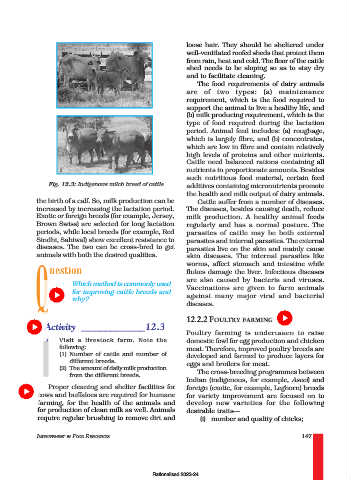Page 159 - Understanding NCERT Science 09
P. 159
loose hair. They should be sheltered under
well-ventilated roofed sheds that protect them
from rain, heat and cold. The floor of the cattle
shed needs to be sloping so as to stay dry
and to facilitate cleaning.
The food requirements of dairy animals
are of two types: (a) maintenance
requirement, which is the food required to
support the animal to live a healthy life, and
(b) milk producing requirement, which is the
type of food required during the lactation
period. Animal feed includes: (a) roughage,
which is largely fibre, and (b) concentrates,
which are low in fibre and contain relatively
high levels of proteins and other nutrients.
Cattle need balanced rations containing all
nutrients in proportionate amounts. Besides
such nutritious food material, certain feed
Fig. 12.3: Indigenous milch breed of cattle
additives containing micronutrients promote
the health and milk output of dairy animals.
the birth of a calf. So, milk production can be Cattle suffer from a number of diseases.
increased by increasing the lactation period. The diseases, besides causing death, reduce
Exotic or foreign breeds (for example, Jersey, milk production. A healthy animal feeds
Brown Swiss) are selected for long lactation regularly and has a normal posture. The
periods, while local breeds (for example, Red parasites of cattle may be both external
Sindhi, Sahiwal) show excellent resistance to parasites and internal parasites. The external
diseases. The two can be cross-bred to get parasites live on the skin and mainly cause
animals with both the desired qualities. skin diseases. The internal parasites like
worms, affect stomach and intestine while
Q 1. Which method is commonly used are also caused by bacteria and viruses.
uestion
flukes damage the liver. Infectious diseases
Vaccinations are given to farm animals
for improving cattle breeds and
against many major viral and bacterial
why?
diseases.
12.2.2 POULTRY FARMING
Activity _____________12.3
Poultry farming is undertaken to raise
• Visit a livestock farm. Note the domestic fowl for egg production and chicken
following: meat. Therefore, improved poultry breeds are
(1) Number of cattle and number of developed and farmed to produce layers for
different breeds. eggs and broilers for meat.
(2) The amount of daily milk production
The cross-breeding programmes between
from the different breeds.
Indian (indigenous, for example, Aseel) and
Proper cleaning and shelter facilities for foreign (exotic, for example, Leghorn) breeds
cows and buffaloes are required for humane for variety improvement are focused on to
farming, for the health of the animals and develop new varieties for the following
for production of clean milk as well. Animals desirable traits—
require regular brushing to remove dirt and (i) number and quality of chicks;
IMPROVEMENT IN FOOD RESOURCES 147
Rationalised 2023-24

